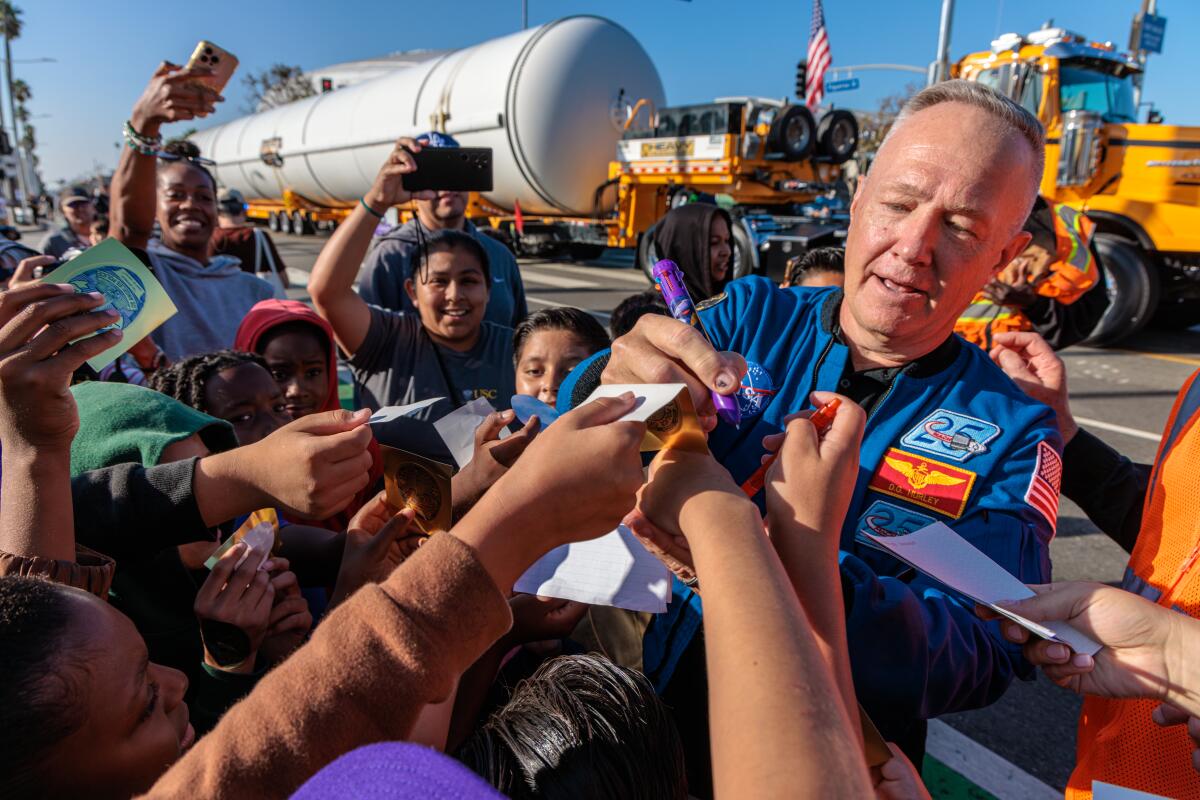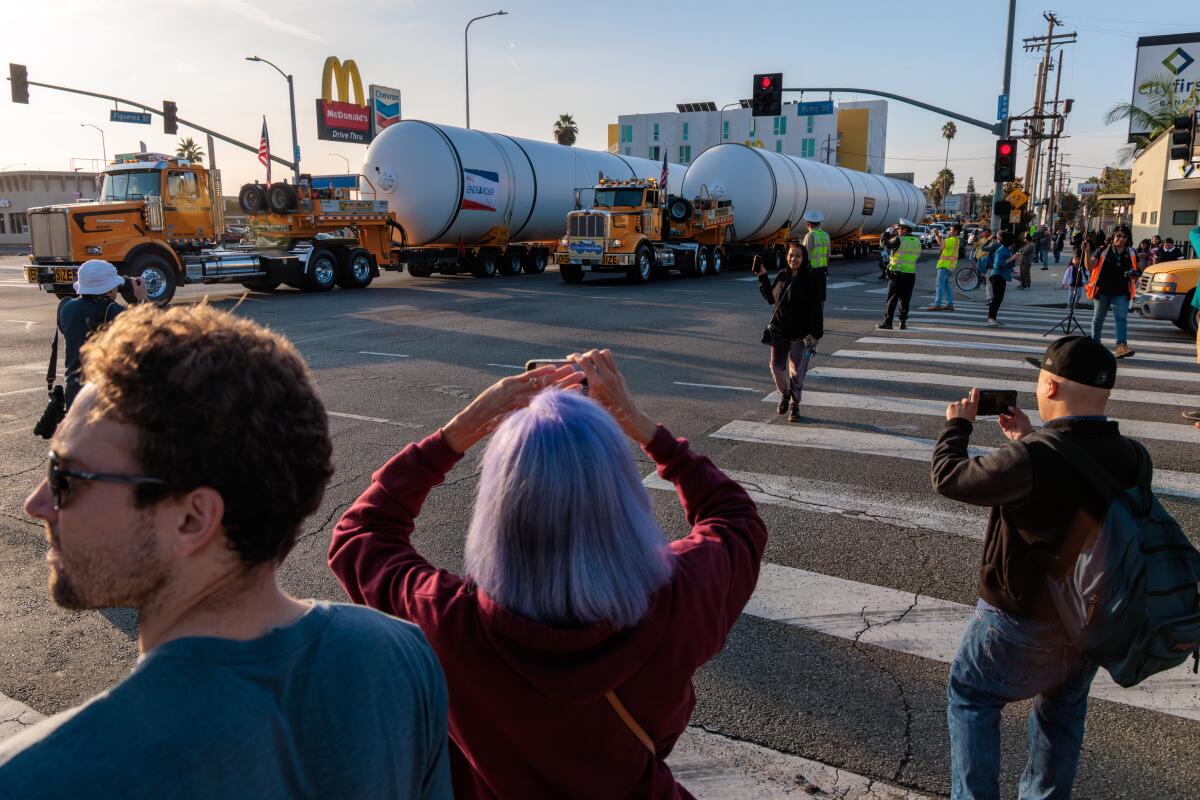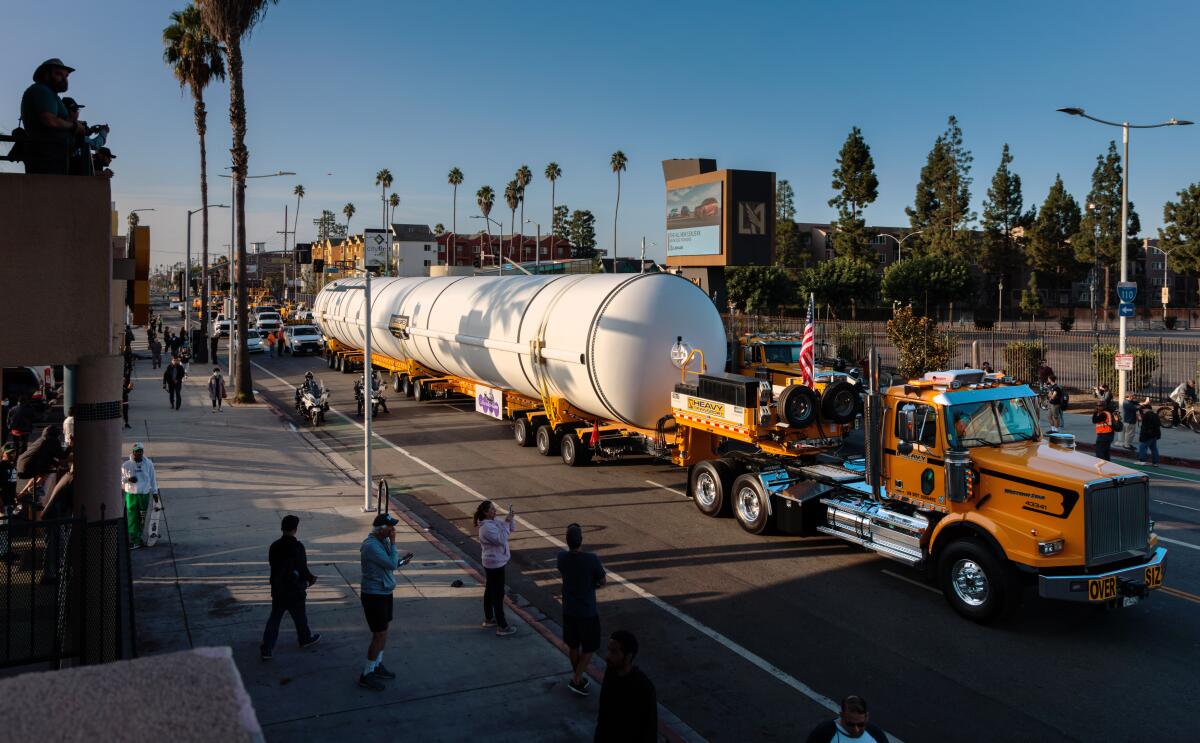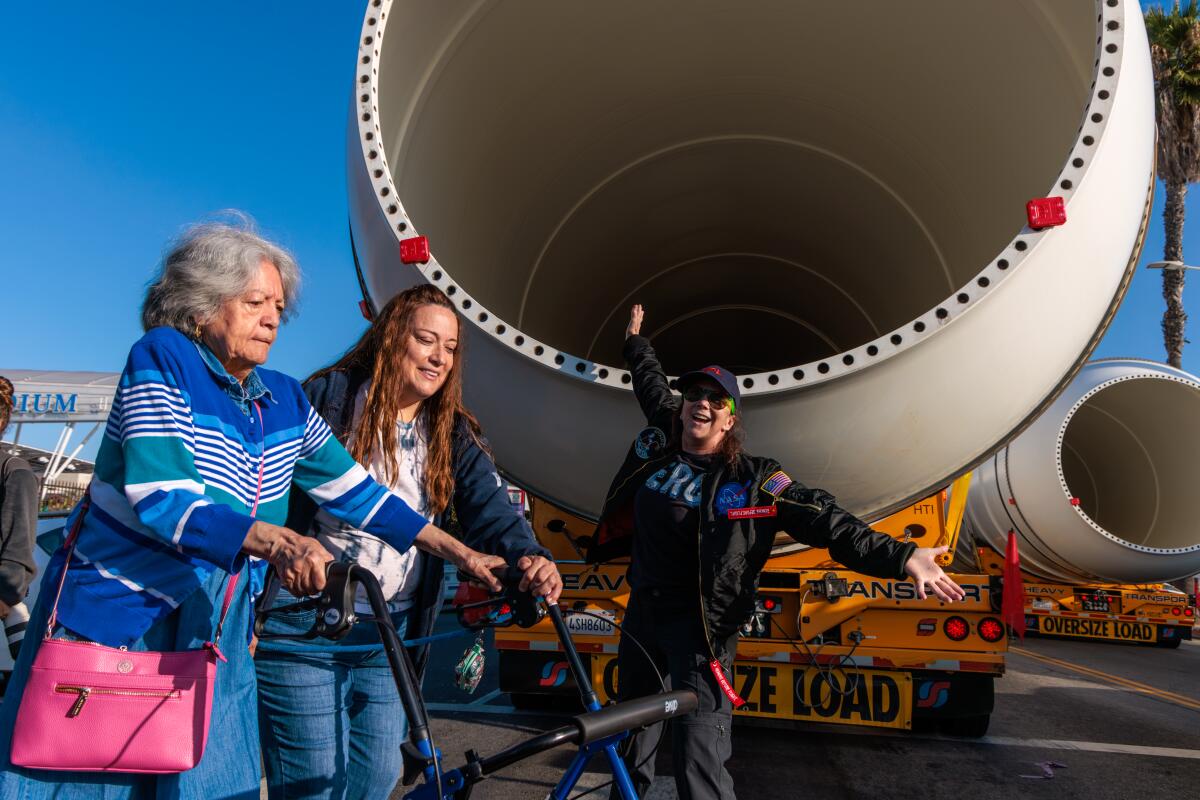Los Angeles on Wednesday welcomed the arrival of its giant twin rockets, the last pieces of space shuttle heavy equipment before it is fully assembled in a major museum exhibit next year, with a celebration fit for the stars.
The solid rocket motors, each weighing 104,000 pounds and as large as the fuselage of a Boeing 757, were transported from the Mojave Air and Space Port in two semi-trucks, taking nine hours over two days and seven I crossed the Southern California Expressway and arrived at the California Science Center. The South Los Angeles center motor occupies most of the length of the white solid rocket booster, which sits under the Space Shuttle’s wings and generates more than 80 percent of its lift during takeoff.
The device will be a key component of the permanent exhibit on Endeavor, the last space shuttle built. After lying horizontally in the museum for more than a decade, it will be configured into a full-stack configuration as if preparing for launch at the new $400 million Samuel Oshin Air and Space Center.
“I’m so excited to see this happening,” said Linda, wife of the late Los Angeles businessman and philanthropist Samuel Oshin, an avid space enthusiast, and the namesake of the new museum. Oshin said. “The Shuttle was everything he loved rolled into one.”
The solid rocket motor departed from Mojave on Tuesday morning and traveled three hours through the desert and Cajon Pass, before stopping for about 15 hours in the San Gabriel Valley. The trip resumed around 3 a.m. Wednesday, and the motor sped off the 110 Freeway and along Figueroa Boulevard in South Los Angeles before arriving around 9 a.m.
Elementary school students and adults alike gathered there to cheer on the spectacle.
Several special guests were also in attendance, including former astronaut Douglas G. Hurley, 57. He flew the last Space Shuttle mission on Atlantis in 2011 and participated in the Endeavor flight in 2009. He later served as the captain of the first spaceship. In 2020, SpaceX Crew Dragon successfully completed a manned flight and stayed on the International Space Station for 62 days. Hurley is currently a senior director at Utah-based Northrup Grumman Space Systems, where he works on developing solid rocket boosters.

Former astronaut Douglas G. Hurley signs autographs Wednesday for students who came to witness the arrival of the solid rocket motor.
(Irrfan Khan/Los Angeles Times)
Spectators came on foot and on bicycles, eager to take photos with their cellphones and pose in front of the impressively large rocket motor.
Jeffrey Rudolph, director of the California Science Center, marveled at how the space shuttle has become an indelible part of the city of Los Angeles since it arrived at the museum in 2012. At the time, Endeavor’s flight, aboard a modified Boeing 747, left Californians gasping as it soared through the sky. See the Golden Gate Bridge and Hollywood Sign before landing at Los Angeles International Airport.
Rudolph said he spoke with a man who recalled bringing his date 11 years ago to watch the Endeavor slowly move through the city. It was a three day, 12 mile trip from the airport to South Los Angeles.
The couple have since married, and on Wednesday they brought their children to see part of the space shuttle system once again rolling through the city.

Two solid rocket motors are trucked to the California Science Center.
(Irrfan Khan/Los Angeles Times)
The solid rocket booster installed at the science center is authentic, and its parts have been used in numerous Space Shuttle launches, from Columbia’s fifth shuttle mission in 1982 to Discovery’s final flight in 2011. or has been reused. The two solid rocket motor components flew on a total of 81 Space Shuttle flights and 32 static tests.
The reusable booster generated more than 6 million pounds of thrust during liftoff and ignited only after the space shuttle’s main engines reached full thrust, according to the science center. At launch, each motor contained approximately 1.1 million pounds of polybutadiene acrylonitrile copolymer propellant. This has the consistency of a pencil eraser.
The solid rocket booster was donated to the California Science Center by Northrop Grumman, which manufactures the device in Utah. In the space shuttle era, they were transported by train to Kennedy Space Center in Florida and returned to Utah for future flights.
Notably, a modified version of the same solid rocket booster was used on NASA’s New Moon rocket, the first Artemis mission to test fly last year. According to NASA, the main difference between the space shuttle’s rocket boosters and the moon rocket’s rocket boosters is the addition of a fifth propellant to the four-segment shuttle booster, which allows modern rockets to lift more weight. It is now possible to do so.

Two solid rocket motors are trucked to the California Science Center.
(Irrfan Khan/Los Angeles Times)
For the next several weeks, this will be the only time all of the shuttle’s major components, including the Endeavor orbiter, solid rocket boosters and giant orange external tank, will be on view unassembled at the science center. During this period, a solid rocket motor will be installed next to the museum’s dining terrace.
In early November, the California Science Center plans to use a crane to lift the rocket motor into place and attach it to the top of the solid rocket booster’s base, known as the aft skirt. The crew will probably install one rocket motor a day, but considering he needs over 100 bolts to secure the rocket motor to the rear skirt. This task can be difficult.
The tip of the solid rocket booster, the forward assembly including the nose cone and front skirt, is then mounted on top of the solid rocket motor. However, before installation, workers must erect scaffolding to properly secure the bolts.
This will set the stage for the installation of the orange external tank, which should be completed by early January, followed by the Endeavor installation by the last week of January. The tallest crane will be as tall as City Hall and will lift Endeavor from its horizontal position and point it vertically toward the stars for its final display. The rest of the museum will then be built around it.

Brian Brosey (right) poses for a photo with a solid rocket motor being trucked to the California Science Center.
(Irrfan Khan/Los Angeles Times)
Since her arrival in 2012, Endeavor has been on display in the temporary Samuel Oshin Pavilion, where it will remain on display until December 31st. After that date, it could be years before Endeavor can be seen up close in a museum again. guest.
In mid-2022, the California Science Center broke ground on its new permanent museum, and construction crews began installing the base of the shuttle’s full stack three months ago.
